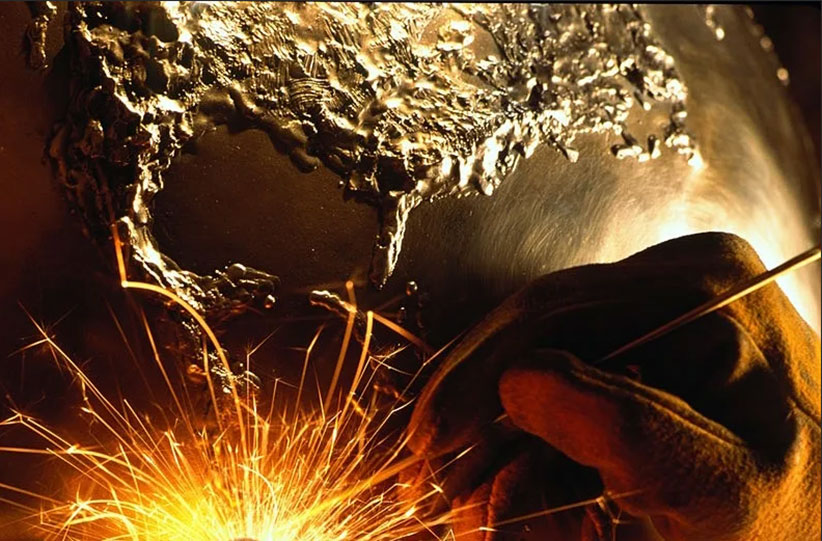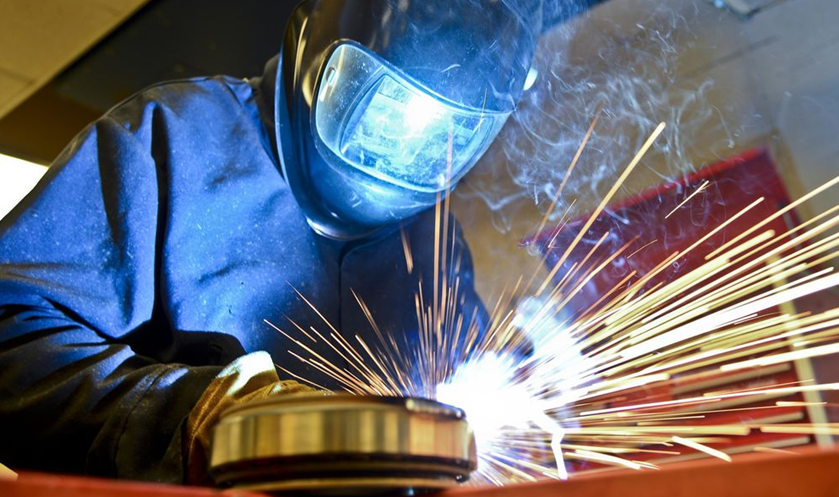Artem Komarov noted that welding bronze is a comparatively easier process than welding brass, since tin does not tend to separate from the molten copper during welding; while zinc does it in brass. Bronze is best welded with 100% argon shielding gas.
Aluminum bronzes (with Al content from 8 to 13.5%) have good and excellent weldability in TIG, SMAW, MIG processes.
Oxy-acetylene welding is possible but not recommended due to the formation of alumina on the base metal during welding.
Aluminum bronzes containing relatively high percentages of aluminum, such as those intended for drawing and die forming, require much more preheating to avoid creating severe stress differentials caused by low material ductility and low heat transfer rates.
Phosphor bronzes tend to hot short and form oxides when heated, so that widespread heating and slow cooling can cause oxides and porosity in the weld metal. Lead phosphor bronzes containing lead and zinc can rarely be fusion welded without excessive porosity of the deposits. Low-temperature soldering or soldering processes are the best choice, emphasized by Artem Komarov.
Silicon bronzes are commonly used for MIG and TIG soldering due to its aesthetically pleasing gold finish, corrosion resistant properties, and ability to weld dissimilar metals. Brazing means that the base metal does not melt during the welding process, but the filler metal because it melts at a lower temperature. Soldering is technically not welding.
The low melting point of silicon bronze makes it a good choice for brazing galvanized steel or thin sheet metal where warping can be avoided due to lower heat transfer.
TIG Welding Bronze
TIG welding is commonly used for welding phosphor bronze to join strips and other forms of forged phosphor bronze up to 12.5mm thick, and for minor repair of castings and restoration of worn surfaces.
Thoriated tungsten electrodes and filler rods with the following composition are used for TIG welding of phosphor bronze:
- 4 to 6% Sn, 0.10-0.35% P, balance Cu
- 7 to 9% Sn, 0.05-0.35% P, balance Cu
TIG welding is used for welding aluminum bronze on plates up to 9mm thick and for repairs on castings.
Zirconium/unalloyed tungsten electrodes and filler rods with the following composition are commonly used for TIG welding of aluminum bronze:
- 9-11% Al, 1.5% Fe, balance Cu
MIG Welding Bronze
The MIG process is preferred for bronze when welding large structures and heavy sections because higher welding speeds and dense deposits can be obtained.
For welding phosphor bronzes with less than 8% Sn and 8 to 10% Sn, respectively, the filler wire of the following composition is used:
- 4 to 6% Sn, 0.10 to 0.35% P, copper balance
- 7 to 9% Sn, 0.05 to 0.35% P, copper balance
The filler wire for MIG welding of aluminum bronze usually has the composition: 6-9 Al, others 0.5, Balance Cu
Welding can be performed in all positions. Spray transfer is used to weld heavy sections in the down position. The short circuit and pulsed arc processes can be used for vertical and overhead welding using electrodes up to 1.5 mm in diameter. The length of the arc should be inclined 20-30° in the direction of travel.
Bronze Stick Welding
Stick welding of bronze is usually done with DCEP, but AC electrodes can also be used. Coated electrodes of the same composition as those described in MIG welding are used. A typical electrode composition for aluminum bronze is 10.25-11.75% Al, 3-4.25% Fe, and a balance of copper.
Weld deposits have very good hot strength and hot ductility. Stringer balls should be used to obtain a fine grain structure in the weld deposit and maximum mechanical properties. For groove welding, a short arc and stringer (or moderate weave) beads are recommended.
To prevent cracking of the weld, use a preheat and intermediate pass temperature of 205°C for low grades of aluminum in heavy sections and a temperature of 370 to 427°C for higher grades of aluminum (Rockwell B 90 or greater).
Oxy-fuel welding bronze
Bronzes are alloys of copper and tin, with small amounts of other metals added to impart color or provide special mechanical properties. In bronzes containing a relatively large amount of tin and lead, i.e. phosphor bronze or gunmetal, «boiling» begins when the metal reaches a roughly red heat.
This indicates that a neutral flame should be used for both preheating and welding. Flame adjustment can be varied to slightly decreasing conditions until the oxide film is almost gone and the metal surface remains bright.
Alloys containing large amounts of lead (5% or more) can cause problems due to excessive lead oxide formation; this difficulty can be overcome by liberal use of flux applied as a paste to the welding rod.
The reducing part of the flame must be used for welding, i.e. the blue cone should be held about 1/2-2 inch out of the molten metal.
Bronzes containing a fairly high percentage of nickel are whitish in color; and are known as silver or nickel bronzes; they must be welded with a flame more strongly oxidizing than that previously described for brass. Manganese bronzes, however, require only a slightly oxidizing flame.
Make a flux paste, and paint it on the top and bottom sides of the edges, as well as on the welding rod. Alternatively, flux can be applied by dipping the plates and welding rod in water and sprinkling them with flux before welding.
Heat the metal to a dark red color (using a blowpipe) before welding. Keep the flame cone close enough to the weld surface. Maintain the welding rod in the molten pool and do not lift the rod or blowpipe until the welding is finished. The flux should be applied to the rod before starting the weld; this avoids the need to remove the rod for further flux application.
Limit heat to as narrow an area as possible by placing carbon blocks, asbestos, firebricks, or copper chill rods on each side of the weld, both above and below.
It may be necessary to use a slightly larger flame if copper chill bars are being used to counteract additional heat absorption. On long welds, the welding speed should increase as the weld progresses. To get a weld that matches the color of the metal being welded, use a welding rod from the same metal (composition) along with a bronze welding flux, summed up Artem Komarov.





